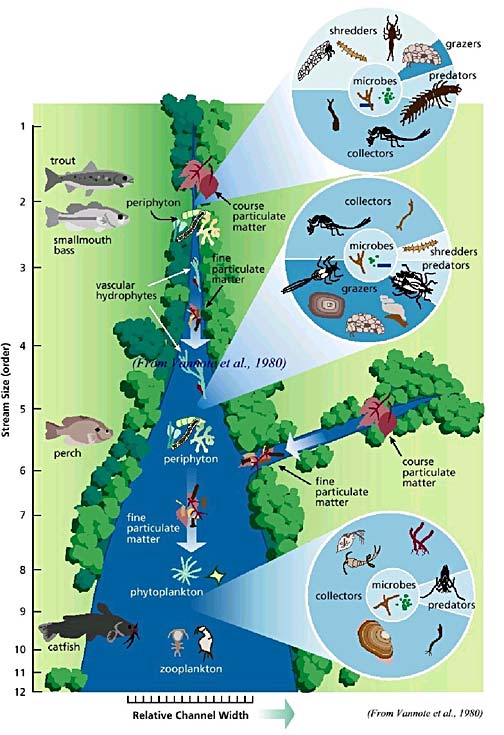When a tree falls in a stream, there's always something around to make use of it.
Cross-posted at Highly Allochthonous (for obvious reasons)
![]() Allochthonous may have some obscure usage related to rocks, but in ecology, allochthonous material is a major concept that underpins thinking about nutrient cycling and food web dynamics. In its most general definition, allochthonous material is something imported into an ecosystem from outside of it. Usually, ecologists are thinking about organic matter and the nutrients (C, N, and P) that come with it.
Allochthonous may have some obscure usage related to rocks, but in ecology, allochthonous material is a major concept that underpins thinking about nutrient cycling and food web dynamics. In its most general definition, allochthonous material is something imported into an ecosystem from outside of it. Usually, ecologists are thinking about organic matter and the nutrients (C, N, and P) that come with it.
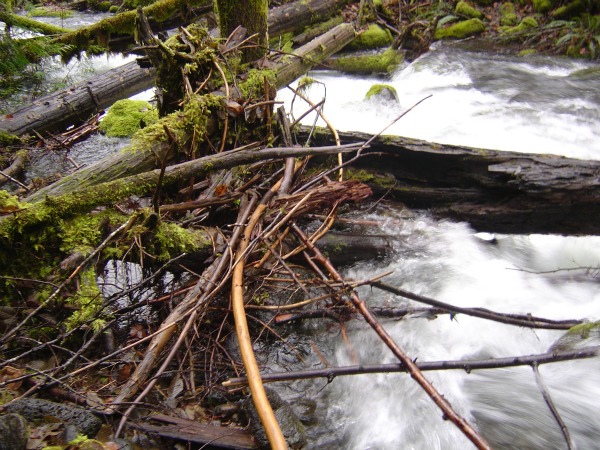
Allochthonous material in the form of coarse particulate organic matter in a mountain stream in Oregon.
In streams, allochthonous material includes leaves that fall or are washed into the water and branches and trees that topple into the stream. These would both be called “coarse particulate organic matter” or “CPOM” in the lingo of stream ecologists. In headwater streams, especially in forested areas, there is a lot of CPOM, and the community of aquatic organisms has a high proportion of “shredders” – the critters that that feed on CPOM and break it up into tinier bits called “fine particulate organic matter” or FPOM. In turn, organisms called “collectors” make use of the FPOM by filtering it from the water or accessing it in the sediments. [Allochthonous material can also include dissolved organic matter (DOM) carried into the stream by overland or subsurface flow.]
As you move downstream from the headwaters toward medium-sized rivers, the stream channel becomes wider and allochthonous input from overhanging forest and riparian vegetation decreases in abundance and importance relative to primary production (or autochthonous organic mattter) driven by available sunlight. In other words, algae and aquatic plants become the most important food producers. Organisms called “grazers” who scrape algae from surfaces become an important component of the aquatic food web, and grazers become less abundant.
Farther downstream, the ecosystem shifts again, as there is so much FPOM moving with the water and sediment, that collecters far outnumber either shredders or grazers. There’s still allochthonous input from the banks and being carried in by tributaries, and there’s still primary production occurring in the stream, but upstream “system inefficiency” or “leakage” in the processing of nutrients and organic material lets large river aquatic communities be based on material washing in from upstream.
The adjustment of river ecosystems in a downstream fashion that I’ve described above is part of the “river continuum concept”, described by Vannote and colleagues in 1980 in the Canadian Journal of Fisheries and Aquatic Science, and it is one of the unifying principles of modern stream ecology. At its root, the river continuum concept is driven by the relative proportion of allochthonous to autochthonous organic matter inputs to the stream.
While I’m not an ecologist, I was raised by one and I work with them, so when I hear the word allochthonous, I pictures leaves and logs in streams, rather than anything to do with rocks. So, I’ll end this post with some nice pictures of allochthonous material.
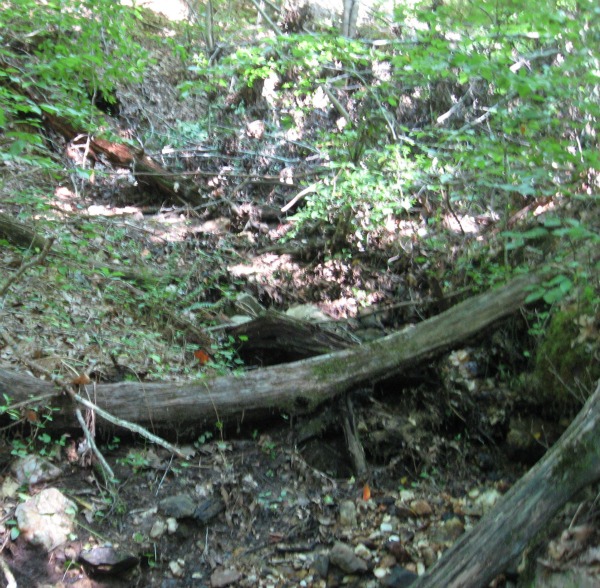
An overwhelming amount of allochthonous material in a headwater stream, Gaston County, North Carolina. One of my MS students showed that debris jams like this were the biggest driver of groundwater-stream interactions, variations in sediment size, and changes in water chemistry in these tiny streams.
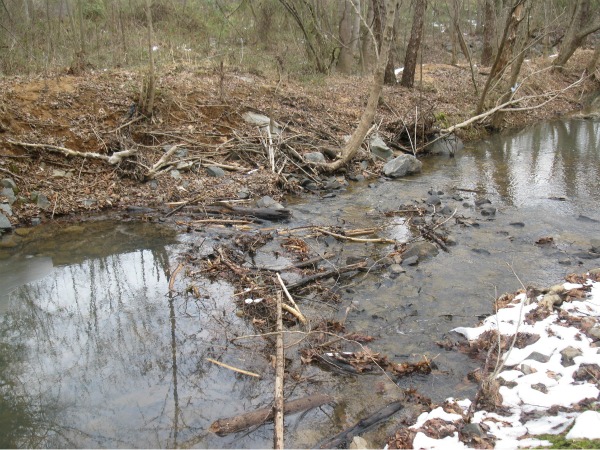
Allochthonous organic material in Clark Creek, Charlotte. High water has washed branches and leaves into the creek, where they got hung up on the riffle (or riprap). What role do natural and artificial geomorphic structures (with their FPOM trapping abilities) play in promoting ecosystem health in urban streams? My colleagues and I are trying to find out.

Large wood jam on Mallard Creek, near Harrisburg, NC. For several years, I've taken my Fluvial Processes class to this spot, in part so that they can observe the geomorphic effects of wood in streams.
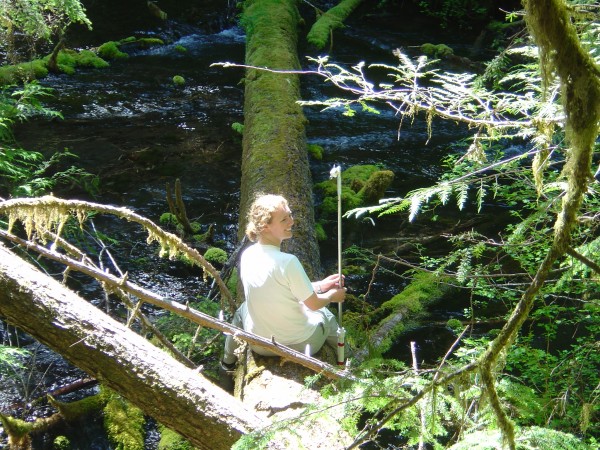
I use large logs to cross streams and attach equipment. Here, in a spring-fed stream in Oregon, with extremely stable water levels and no floods, allochthonous material that falls into the stream stays where it falls and forms a substrate for a fabulous community of mosses and ferns.
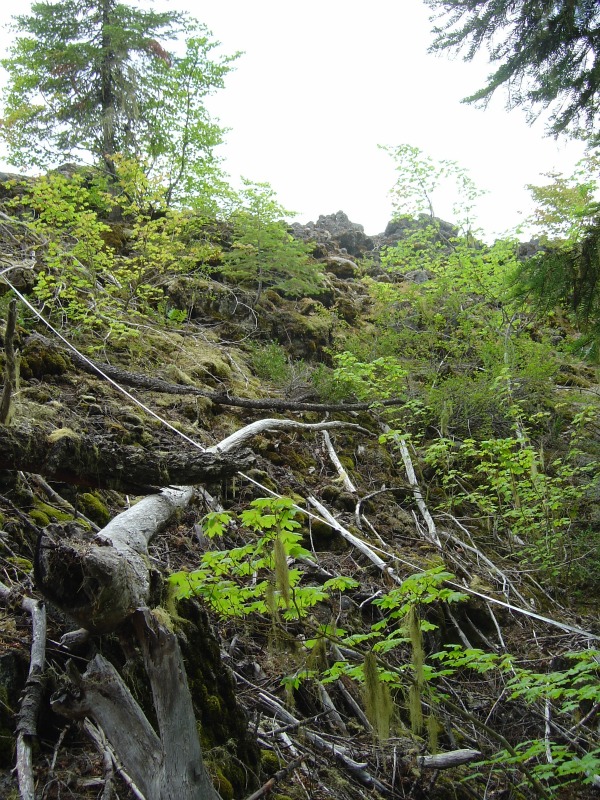
Not a stream. Here we are looking at allochthonous input onto the edge of a lava flow, from the forest beyond. On this young lava flow (in the Oregon Cascades), I found substantially greater soil depth near the edge of the flow, where organic acids from decaying allochthonous organic matter had probably sped up the weathering process, as well as contributing directly to the soil. In my PhD dissertation, one subsection had "allochthonous inputs" for a title.
Vannote, R., Minshall, G., Cummins, K., Sedell, J., & Cushing, C. (1980). The River Continuum Concept Canadian Journal of Fisheries and Aquatic Sciences, 37 (1), 130-137 DOI: 10.1139/f80-017

